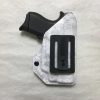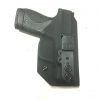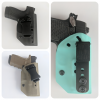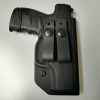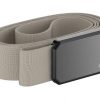Brief Incident Summary: A civilian passerby intervened to help Lee County Sheriff Deputy Dean Bardes as he struggled with an attacker along the Corkscrew Road exit of I-75 after a high speed car chase. The unnamed civilian, a Florida Concealed Weapons License holder, witnessed the officer on the ground being pummeled by Eric Strother and approached with his firearm drawn. He commanded Strother to stop beating the officer. Strother continued beating the officer and, as the officer yelled for help, three shots were fired into the attacker. Several other motorists witnessed the events unfolding, but only one was prepared to take action to save the officer’s life. More details on the incident can be found in this article from the local News-Press.
Since this officer-involved shooting happened so close to home (just a few miles…) and was featured in the local news, we thought it would make for interesting analysis. Of course, we are not legal experts, nor are we familiar with all of the evidence of the case. However, eyewitness testimony and reporting by the local media and Sheriff’s office, plus what we know about self-defense law all suggest that this was a justifiable shooting.
The Reasonable Man Doctrine
For a homicide to be justifiable, there must be an immediate and otherwise unavoidable danger of death or great bodily harm to an innocent person. Read that sentence again and note that every word counts. Also, it is like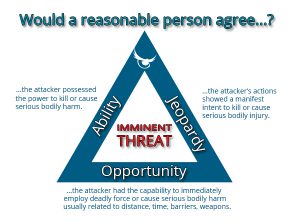 ly a jury will be asked to determine if “any reasonable and prudent person would have done the same thing in the same situation, knowing what the defendant knew at the time.” For specific analysis, the Ability-Opportunity-Jeopardy Triad can be used to arrive at a defensible answer to these questions.
ly a jury will be asked to determine if “any reasonable and prudent person would have done the same thing in the same situation, knowing what the defendant knew at the time.” For specific analysis, the Ability-Opportunity-Jeopardy Triad can be used to arrive at a defensible answer to these questions.
**In answering all of these questions, we must consider that the attacker may have been attempting to take or may have taken the officer’s firearm. It is not clear from the reporting as of yet if this was the case, but this possibility represents a clear deadly threat to the officer, the armed civilian and possibly other innocent bystanders.
Did the attacker have the ABILITY to cause grievous bodily harm or death?
Many will ask if the attacker was armed. In this case, it does not appear that he was armed with a firearm, however, he was armed with hands and feet that were engaged in beating the officer. While only hands and feet may not be enough to cause great bodily harm or death, there is a legal concept in self-defense cases called Disparity of Force that suggests that sometimes an attacker can have unfair advantage on a defender. Some examples are using multiple attackers, a young person against a very old person, or having greater size or strength than the victim. In this case, the attacker was able to pin the officer on the ground putting the officer in a “position of disadvantage”. Physical blows hit harder and cause more damage when the body/head are not able to “roll with the punch” because the ground stops the momentum. Moreover, the officer is unable to escape or otherwise fight back in a normal manner.
Disparity of force issues are often the key to understanding why the lethal use of a firearm may be justified against an attacker that does not have a firearm. If you remember the high profile State of Florida vs. George Zimmerman case (Go HERE for excellent analyses), the same disparity of force issue was key – the fact that the defendant was pinned on the ground and the attacker was pounding his head into the concrete sidewalk perfectly represents a clear position of disadvantage for the defendant.
Did the attacker have the OPPORTUNITY to cause grievous bodily harm or death?
The opportunity element is mostly based on distance and time. If an attacker has the power to cause great bodily harm or death, but is not close enough to exercise that power, then shooting in self-defense may not be justified. Or, if a powerful attacker says he will come back tomorrow and kill you, then you are not justified in shooting him today. In this incident, when the civilian decided to intervene, the attacker had the officer pinned on the ground (distance: physically in-contact) and was actively pummeling him with blows (time: right now). This represents a clear and present opportunity for the attacker to cause grievous bodily harm and if the event was not stopped, possible death.
Was the element of JEOPARDY present?
Did the attacker’s actions and words manifest intent to cause grievous bodily harm or death? As told by witnesses, the attacker was on top of the officer pummeling him with blows and the officer was yelling for help. These actions by the attacker show a manifest intent to cause great bodily harm and if unchecked, potential death. The officer was clearly in distress and the attacker was clearly ignoring the officer’s pleas for him to stop and the armed citizen’s command to stop. If, upon hearing the command to stop, the attacker immediately ceased punching and put his hands in the air, his actions would have communicated something entirely different.
Summary
By answering these questions, it should be clear that there was immediate and otherwise unavoidable danger of death or great bodily harm to an innocent person (the officer) and any reasonable and prudent person (such as the armed citizen or another bystander) would have come to the aid of the officer who was being attacked. Thus, based on the facts that have been reported so far, the incident seems to be a justifiable self-defense shooting. Any responding law enforcement officer would have had a duty to respond in the same manner under the same circumstances. The armed civilian did not have a duty to respond, but was justified in his action.
Despite this being justifiable self-defense, the armed civilian and the families involved on both sides may still face a lengthy and costly legal battle and will most certainly be dealing with a wide range of emotional stresses after such an incident. Our thoughts and prayers go out to them.
Anyone interested in the concepts presented in this article should read Deadly Force by Massad Ayoob and Law of Self-Defense by Andrew Branca. Both of these books should be required reading for any responsible concealed carrier.




